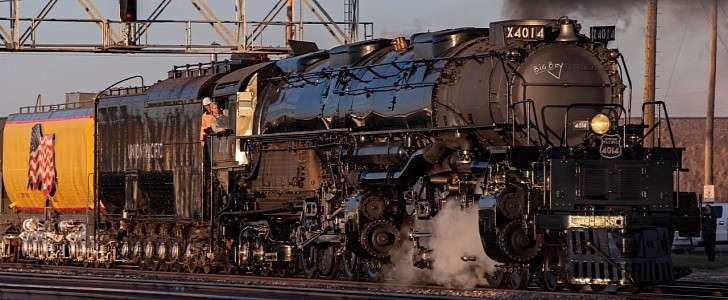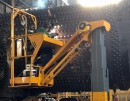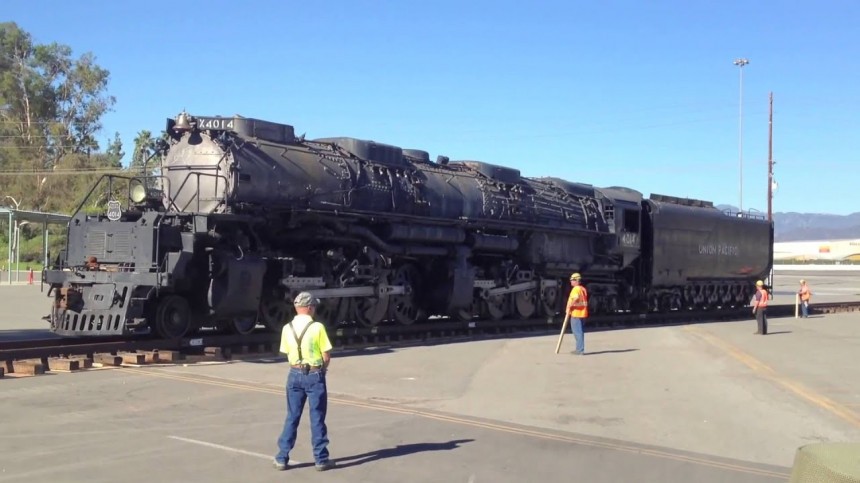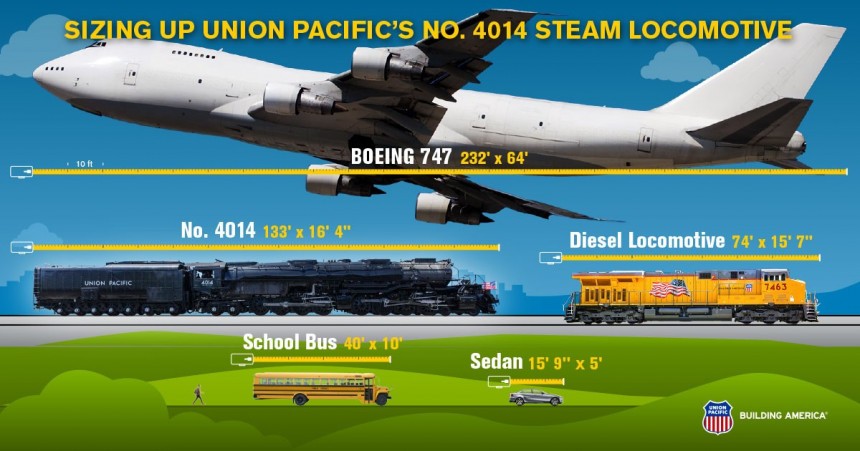Everyone said it was impossible, so that’s why a dedicated team of engineers and craftsmen spent six years and countless millions of dollars restoring the largest steam locomotive of all time.
During the darkest days of WWII, Union Pacific needed raw power to carry tanks, artillery, and raw materials over the steep Wasatch Mountains between Ogden, Utah and Green River, Wyoming. The time wasted on coupling another locomotive to the trains along with twice the maintenance costs prompted them to build something unprecedented.
In order to run comfortably at 80 mph, they would need a boiler capable of 300 psi (20.6 bar). Longer than 2 buses, it literally wouldn’t go around corners. This led them to split the running gear with a massive hinge in the middle. Essentially two normal-size steam engines coupled together under a common boiler, it is 85 feet long (26m) and 16 feet (5m) high. When coupled to the tender (coal hopper), it weighs in at only 1,280,750 pounds (548,300 kg).
Only 25 were built between ‘41 and ‘44, and the best candidate for restoration was #4014, as it had been on display at the L.A. Fairgrounds since 1962. Being 1,200 miles away from Cheyenne, Wyoming the first hurdle was getting it back on rails. After splicing a switch into the Metro-Rail commuter line, they used 40’ (12.1m) sections of track to leap-frog across the parking lot.
A “Hospital Train” of 14 cars arrived from Wyoming, loaded with machine tools, replacement parts, and a dozen of the last steam engineers who lived and worked alongside the beast for 3 months. After replacing the brakes and greasing over 200 bearings, two diesels towed it at 30 mph back to Wyoming where it arrived in May of 2014. After a year of disassembly, two massive cranes were used to split the front and rear engines by removing the 450 lb (204 kg) hinge pin. Each engine has two 24” (603mm) pistons driving four 68” (1,727mm) wheels.
This revealed 20 years of grease and coal cinders packed into the hollow central spines. Under this, two lubrication systems supplied valve oil and bearing grease to hundreds of nozzles, and it all was removed. That is when they realized the tools needed for such big parts no longer exist. Digging into the original blueprints, Chief Engineer Ed Dickens sent bids around the world to procure new equipment. This allowed every threaded connection and fitting to be removed and replaced with new parts made in-house.
She was parked after 20 years and 1.7 million tortuous miles. Even the best steel can crack under those conditions. Therefore, every surface was scanned with ultrasound to provide a map of stress and fatigue. This led to the decision to rebuild the boiler and firebox by late 2016. Like building a ship in a bottle, work was done bolt by bolt from the inside out.
This allowed them to change the way the beast is fed. At full throttle, Big Boy consumed 11 tons of coal and 12,000 gallons (45,000 liters) of water every hour. This prompted the conversion to burning oil. An atomizer was designed to mix steam with #5 fuel oil to create a hotter and more consistent fire, without belching burning cinders onto the Great Plains.
New coil and leaf springs replaced all the old suspension, as re-assembly headed into the Summer of 2018. A new cab was fabricated to include modern amenities, including the latest communications and safety gear, and her first test run was May 9th of 2019. Originally rated at 6,290 horsepower and 135,375 lb-ft, Union Pacific estimates 4014 easily makes much more. Here’s to UP for preserving this piece of American history.
In order to run comfortably at 80 mph, they would need a boiler capable of 300 psi (20.6 bar). Longer than 2 buses, it literally wouldn’t go around corners. This led them to split the running gear with a massive hinge in the middle. Essentially two normal-size steam engines coupled together under a common boiler, it is 85 feet long (26m) and 16 feet (5m) high. When coupled to the tender (coal hopper), it weighs in at only 1,280,750 pounds (548,300 kg).
A “Hospital Train” of 14 cars arrived from Wyoming, loaded with machine tools, replacement parts, and a dozen of the last steam engineers who lived and worked alongside the beast for 3 months. After replacing the brakes and greasing over 200 bearings, two diesels towed it at 30 mph back to Wyoming where it arrived in May of 2014. After a year of disassembly, two massive cranes were used to split the front and rear engines by removing the 450 lb (204 kg) hinge pin. Each engine has two 24” (603mm) pistons driving four 68” (1,727mm) wheels.
This revealed 20 years of grease and coal cinders packed into the hollow central spines. Under this, two lubrication systems supplied valve oil and bearing grease to hundreds of nozzles, and it all was removed. That is when they realized the tools needed for such big parts no longer exist. Digging into the original blueprints, Chief Engineer Ed Dickens sent bids around the world to procure new equipment. This allowed every threaded connection and fitting to be removed and replaced with new parts made in-house.
This allowed them to change the way the beast is fed. At full throttle, Big Boy consumed 11 tons of coal and 12,000 gallons (45,000 liters) of water every hour. This prompted the conversion to burning oil. An atomizer was designed to mix steam with #5 fuel oil to create a hotter and more consistent fire, without belching burning cinders onto the Great Plains.
New coil and leaf springs replaced all the old suspension, as re-assembly headed into the Summer of 2018. A new cab was fabricated to include modern amenities, including the latest communications and safety gear, and her first test run was May 9th of 2019. Originally rated at 6,290 horsepower and 135,375 lb-ft, Union Pacific estimates 4014 easily makes much more. Here’s to UP for preserving this piece of American history.











